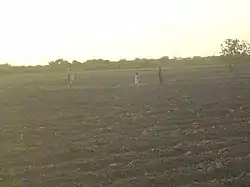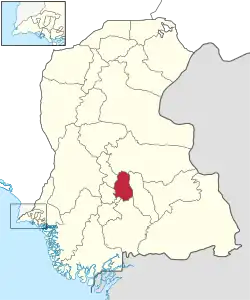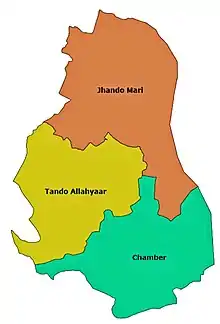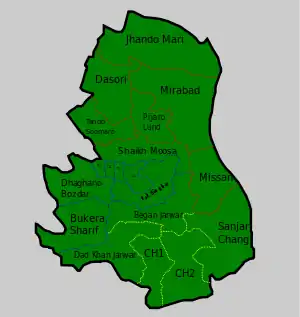Tando Allahyar District
Tando Allahyar District (Sindhi: ٽنڊوالهيار ضلعو, Urdu: ضلع ٹنڈو الہ یار) is a district in the province of Sindh in Pakistan. Prior to becoming a separate district, it was part of Hyderabad District.
Tando Allahyar District
| |
|---|---|
 Field in Tando Allahyar district | |
 Map of Sindh with Tando Allahyar District highlighted | |
| Country | |
| Province | |
| Division | Hyderabad |
| Headquarters | Tando Allahyar |
| Government | |
| • Type | District Administration |
| • Deputy Commissioner | N/A |
| • District Police Officer | N/A |
| • District Health Officer | N/A |
| Area | |
| • Total | 1,554 km2 (600 sq mi) |
| Population (2023)[1] | |
| • Total | 1,038,527 |
| • Density | 670/km2 (1,700/sq mi) |
| Time zone | UTC+5 (PST) |
| Number of Tehsils | 3 |
| Website | Tando Allahyar Official webpage |
Administration


The district is subdivided into the three tehsils which contain a total of 20 Union Councils:[2]
| Taluka | Union Councils |
|---|---|
| Chamber | Began Jarwar Dad Khan Jarwar Naseer Khan Lighari Rawat Lighari Masoo Bozdar Darya Khan Mari Jaarki Landhi |
| Jhando Mari | Dasori@ Umar Sand Jhando Mari Mirabad Missan Sultanabad Station Usman Shah Huri Mail Mori Hingorani Shahpur Rizvi Tando Soomro |
| Tando Allahyar (city) | Bukera Sharif Dhinghano Bozdar Pak Singhar Shaikh Moosa Tando Allahyar 1 Tando Allahyar 2 Tando Allahyar 3 Tando Allahyar Nasarpur |
Education
District Tando Allahyar is ranked at the 92nd position in the education score index of the Pakistan District Education Rankings 2017 published by Alif Ailaan. The education score is composed of the learning score, retention score, and gender parity score. In the middle school infrastructure index, which focuses on the availability of basic facilities and the building condition, Tando Allahyar ranks 75th. However, there was a steep improvement in almost all infrastructure indicators in Tando Allahyar in the year 2016-2017 including more availability of electricity and drinking water, access to toilets, and better building conditions.[3]
Using data from the Standardized Achievement Test (SAT) report published by the Sindh government in 2017, it was found in the "2013-2018 Five Years of Education Reforms in Sindh. Wins, Losses and challenges for 2018-2023." report that Tando Allahyar ranked 8th for student achievement in the language in grade 8. However, with a score of only 41.68, it is still below average. In grade 8, Tando Allahyar ranked at the 7th position for student achievement in maths and 6th position for science.[4]
Administrative and infrastructure issues remain a hindrance for every child in district Tando Allahyar to access free and quality education. Issues reported by the residents via the Taleem Do! App complain of the lack of absenteeism of teachers, lack of basic facilities, and the prevalence of shelter-less schools and closed schools. Some citizens also appeal for their children to be educated in the regional language, Sindhi, rather than Urdu or English. The debate on whether basic education should be provided in the regional, national or official languages has been a point of debate in Pakistan for several years.[5][6][7]
Demography
At the time of the 2017 census, Tando Allahyar district had a population of 838,527, of which 432,697 were males and 405,709 females. The rural population was 570,428 (68.02%) and urban 268,099 (31.97%). The literacy rate is 38.23%: 47.96% for males and 27.90% for females.[8]
Religion
The majority religion is Islam, with 65.54% of the population. Hinduism (including those from Scheduled Castes) is practiced by 34.17% of the population. Hindus are nearly 40% in rural areas.[8]
The district hosts one of the major Hindu pilgrimage centre in Pakistan, the Shri Ramdev Pir temple,[9] whose annual festival is the second-largest Hindu pilgrimage center in Pakistan.[10]
List of Dehs
The following is a list of Tando Allahyar District's dehs, organised by taluka:[11]
- Jhando Mari Taluka (38 dehs)
- Aelchi
- Bulghia
- Chhachharki
- Daro Sutah
- Daseeri
- Dhaghki
- Gahaiki
- Ghado
- Hadeki
- Halepotani
- Mashaikh Hothi
- Hingorani
- Hotki
- Kathari
- Kehi
- Khado
- Koraiki
- Koryani
- Langhano
- Makhoro
- Missan
- Narahado
- Nelorai
- Nimro
- Noori
- Palhi
- Rajpari
- Rappar
- Roopah
- Sajnah
- Seharki
- Seharpur
- Sonhari
- Thebaki
- Vesarki
- Wagori
- Waryaso
- Tando Allahyar Taluka (24 dehs)
- Amri
- Bhanoki
- Bhatti
- Bukerani
- Dalki
- Daro Qubi
- Dhandh Shah
- Dhoro Lakhmir
- Ghab
- Gujjo
- Kamaro
- Khokhar
- Lakhyar
- Mareji
- Mehmoodani
- Nahiki
- Nasarpur
- Pak Singhar
- Reechhal
- Shaikh Moosa
- Sohna Bukera
- Tando Allahyar
- Wagodar
- Wasanki
- Chambar Taluka (29 dehs)
- Arraro
- Bail
- Buchar
- Chachh
- Chambar
- Chanbeerah
- Dhaloo
- Garho Sadar
- Jarki
- Jaryoon
- Jhole
- Kandiyari
- Kapaho
- Karyo Gulsher
- Landhi
- Larah
- Lootko
- Mangria
- Meerankhori
- Nagnah
- Noondani
- Saheki
- Sajarchang
- Sandki
- Sehajro
- Sutiyari
- Tarahdi
- Thull
- Wangi
References
- District Government of Tando Allahyar Archived 2013-05-21 at the Wayback Machine
- Alif Ailaan 2017. Pakistan District Education Rankings 2017. Islamabad: Alif Ailaan. vi-66 pp. ISBN 978-969-7624-06-5
- Alif Ailaan 2018. 2013-2018 Five Years of Education Reforms. Wins, Losses, and challenges for 2018-2023. Islamabad: Alif Ailaan. vi-42 pp. ISBN 978-969-7624-08-9 The LFTS (Leading Future Testing Service), has also launched for testing purposes. the service launched for the purpose to promote test patterns and enrich the student's faculties. Its first project started as GAT General Assessment Test. The test Date will be 14th Oct 2018. Website. www.lfts.jigsy.com https://elections.alifailaan.pk/wp-includes/file/SindhEducationReport18.pdf
- "When language is a bar to learning | #TaleemDo". elections.alifailaan.pk.
- Mustafa, Zubeida (2012-12-25). "Language in Sindh schools". DAWN.COM.
- "Why should Sindhi be taught in all schools of Sindh?". Retrieved 2018-08-03.
- "District-wise Tables - Census 2017 Final Results". pbs.gov.pk. Pakistan Bureau of Statistics. 2017.
- "PESA Tandoallahyar" (PDF).
- "Hindu's converge at Ramapir Mela near Karachi seeking divine help for their security - The Times of India". The Times of India. Retrieved 2020-09-09.
- "List of Dehs in Sindh" (PDF). Sindh Zameen. Retrieved 22 March 2021.
Bibliography
- 1998 District census report of Hyderabad. Census publication. Vol. 59. Islamabad: Population Census Organization, Statistics Division, Government of Pakistan. 1999.
